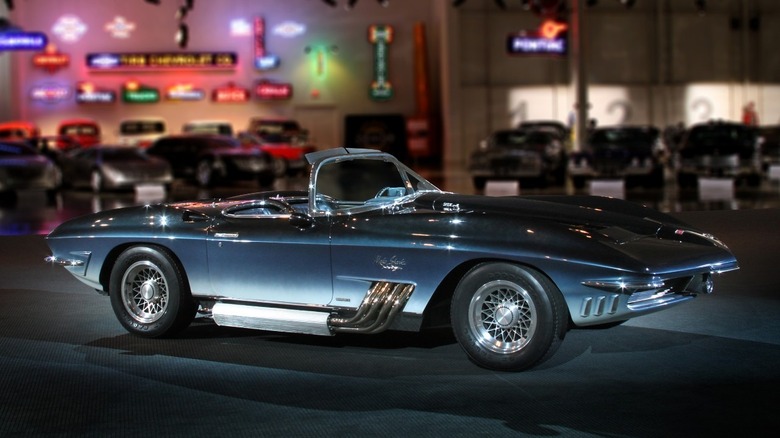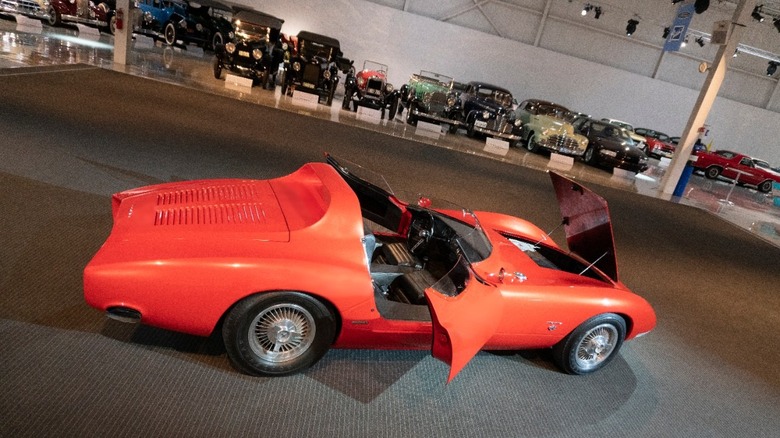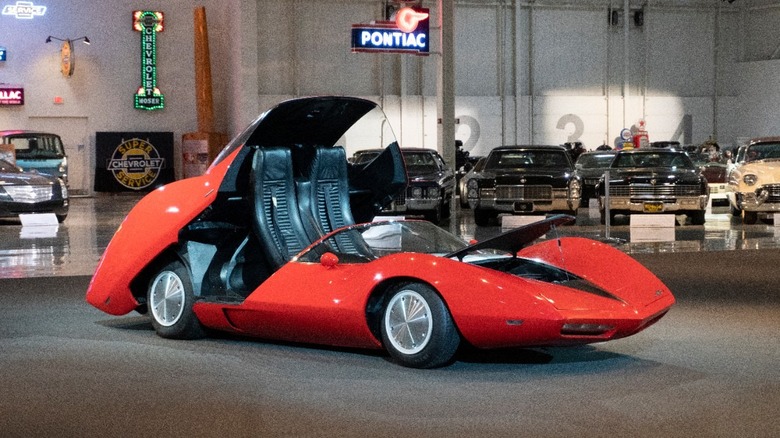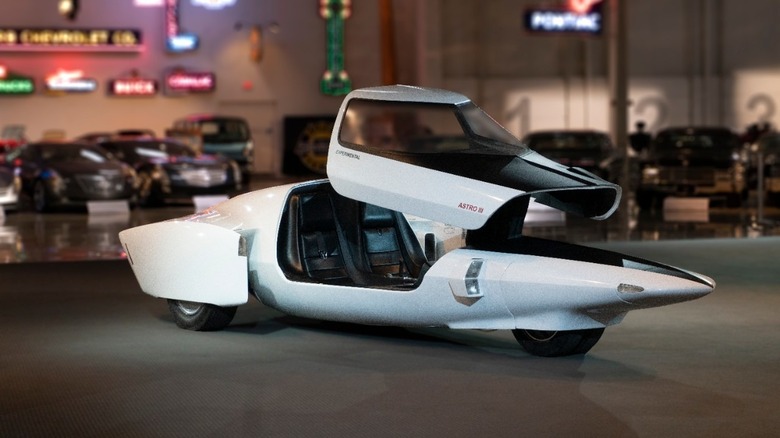7 Cool Chevrolet Concept Cars That You Probably Didn't Know Existed
Concept cars are one of the cooler parts of the automotive industry. In a world of mass-produced modes of transportation, concept cars are true flights of fancy. They exist to push the envelope, testing wild and crazy design ideas, new materials, or cutting-edge technologies.
The dreaded "bottom line" almost always favors function over form, though, as the former is far more cost-effective to build. If a vehicle is lucky enough to move beyond the concept phase one might see displayed on the car show circuit to one that rolls off the assembly line, it usually has morphed from the incredible work of art it once was into a quite unfamiliar machine that's far more utilitarian.
The first concept car — the Buick Y-Job — was created by General Motors design chief Harley Earl in 1938. Since then, scores of concept cars have been built by virtually every car maker, and most are completely unknown to the general public. We understand that what defines "cool" is entirely subjective and can be hotly debated. Given that, here are seven of what we think are the coolest concept cars Chrysler ever created.
1961 Mako Shark I Corvette
The name of Chevy's incredible sports car was taken straight from the small, fast class of naval warship bearing the same name. Today, the Corvette is synonymous with Chevrolet. In fact, this entire list could easily consist of nothing but Corvette concepts, like the forgotten CERV III concept known as the "first functional, electronic high-tech Corvette concept car."
A few years later, the vice president of GM's Styling Staff (now General Motors Design Center) caught a Mako Shark while deep-sea fishing off the coast of Florida. He thought its sleek appearance and pointed nose would look great on a Corvette, and in 1961, the experimental Mako Shark Corvette show car (known as XP-755 internally) was created.
They took the shark idea so far that the car was painted with various shades of iridescent blue that gradually gave want to white sides and lower body, mimicking the colors on the Mako. The menacing nose, "gills" acting as lights below the front bumper, and the four-into-two side pipes all made it look very much like a shark.
During its tenure, the Mako was fitted with various experimental engines, including a fuel-injected engine, a V8 with two four-barrel carburetors, and even a supercharged engine with four side-draft carburetors. According to GM, the engine currently sitting in the Mako only has one four-barrel carburetor attached to a 427-cubic-inch (7.0-liter) ZL-1 V8 from 1969, kicking out nearly 425 hp. The block, heads, and intake manifold are all made from aluminum.
1963 Corvair Monza SS
In 1962, Chevy concocted the Corvair Monza GT Concept. While the sporty version of the Corvair was cool, the Monza SS (basically a Monza GT without a roof) produced a year later (in 1963) absolutely oozed charisma.
Both were shown to the public at the 1963 New York Auto Show and were briefly tabbed for mass production as low-cost sports cars. However, the GT was too heavy, and the SS proved impractical despite having some seriously high-tech features, including magnesium wheels and a lightweight fiberglass body. The GT and SS were both designed by Tony Lapine and Larry Shinoda, who worked under GM designer Bill Mitchell (who caught and then developed the Mako Shark concept).
The roofless SS had sleek contours, and a short, racing-inspired windshield. The front headlights were molded into the shark-like nose with Lexan covers, while oval-shaped exhaust ports from a modified exhaust system sat on opposite sides of the car.
The fin that rose from the deck behind the passenger compartment actually doubled as a built-in roll bar. The deeply recessed contoured bucket seats weren't adjustable, but the steering wheel and foot pedals were moveable. The SS was powered by Chevrolet's incredibly interesting Turbo-Air 6 boxer engine, a rear-mounted, six-cylinder air-cooled Corvair engine with six carburetors, putting more of the car behind the rear wheels than the GT, which had its engine mounted in the middle.
1963 Corvair Testudo
In 1962, Bill Mitchell sent a Corvair Monza coupe to the Italian coachbuilding company Bertone. He was curious to see what the famed design house would do with an American sports car, and because Mitchell was hoping to sell the Corvair across the pond, replete with European flair.
The man assigned to tackle the job was none other than a young Giorgetto Giugiaro (who would go on to found the world-famous Italdesign a few years later). Interestingly, the Testudo — Latin for turtle, hence the badge on the back — was developed simultaneously with the Corvair Monza GT and SS stateside.
Giugiaro started by removing 12 inches from the chassis, reducing the 108-inch wheelbase to 94 inches. He didn't touch the original drivetrain though, an air-cooled six-cylinder boxer engine producing a mere 81 bhp. Since the engine weight was centered over the rear axle it well balanced under braking while giving the vehicle superior traction.
The Testudo body was only 3 feet six inches high, and featured a one-piece pop-up hatch that opened up (sans doors) to reveal the interior. Meanwhile, a sharp crease running around the circumference of the body split it into a top and bottom half, all of which evoked a turtle's shell. Flush-mounted headlights popped up when they were turned on. The cockpit was equipped with bucket seats, an L-shaped instrument panel, and a unique rectangular steering wheel. The car was fully functional and, according to reports, was personally driven by Nuccio Bertone to the Geneva Auto Show in 1963, while Giugiaro drove it back after.
1967 Astro I Experimental
The whole point behind the Astro I was to see the "visual potential of automobile aerodynamic characteristics." When shown at the New York Auto Show in 1967, it wowed the crowd. Again, designed by Larry Shinoda (under the direction of Bill Mitchell), the fiberglass concept boasted bizarre dimensions. The roofline was a mere 2.96 feet (35.5 inches) off the ground. It sat on a 7.33-foot (88-inch) wheelbase, but the body stretched it out to 14.73 feet (176.75 inches) and just over six feet wide.
Furthering the bizarreness, it had a pop-up canopy instead of doors. When raised, the canopy lifted the seats into a near-standing position, letting the occupants clamber in and lean back. As the canopy closed, the seats lowered into a driving position.
Mitchell was enamored with the sea, and many of his designs centered on it. In many respects, the Astro I looked like a blend of a manta ray, Mako shark, and submarine. For instance, since there was no rear window, a rear-view mirror was useless, so it got a periscope-style apparatus, providing the driver with a wider field of view.
While the concept was real (not a mock-up), it never ran. The press release at the time claimed it was powered by a 2.9-liter Turbo-Air 6 boxer engine with a pair of prototype GM three-barrel inline carburetors using Weber guts rated at 240 hp. However, the only engine ever installed was a stock Corvair 140hp, four-carb flat-six. Still, according to GM, the Astro I led to the Corvair platform using a rear-mounted air-cooled engine (sans radiator).
1969 Chevrolet Astro III Experimental
The experimental Astro II that came in 1968 wasn't cool enough to make this list, but the third iteration from '69 is list-worthy. GM's mindset behind the three-wheeled Astro III was to build an experimental vehicle that looked like an executive jet aircraft meant to "travel on restricted access highways of the future." And if you're wondering, yes, this study of low-drag forms was brought to fruition once again by Bill Mitchell and Corvette chief engineer Larry Shinoda.
The Astro III's roof was just 3.36 feet (40.5 inches) off the ground, again, requiring an interesting method to enter the cockpit. Once the canopy popped up and moved forward out of the way, two people could climb into the bucket seats, where they were greeted with an interior that carried on the jet-inspired motif.
Lacking a proper steering wheel, the driver controlled the Astro III with two power-assisted pistol-grip joysticks — one on either side of the driver's seat. Because there was no rear window per se, a rear camera provided images via CCTV to a display screen situated in the center console.
Much like the first Astro sibling, there's no evidence to indicate that the Astro III ever ran. Still, it was powered by a lightweight 317-hp Allison 250-C18 gas turbine engine used in military and civilian helicopters mated to a two-speed Hydramatic transmission.
2015 FNR Concept
The FNR concept shown at the Shanghai Auto Show in 2015 looks like it should be driving around in a Tron movie or slipping through the streets of Night City in CD Projekt Red's dystopian Cyberpunk 2077 video game. When we said concepts were built as flights of fancy, the FNR looked every bit like a vehicle from the future, which was exactly the point of the FNR.
The technology in Chevrolet's autonomous electric concept was mind-bending in 2015. Roof-mounted radar and perimeter sensors mapped out the vehicle's surroundings and fed the data to Chevy's Intelligent Assistant to drive the car autonomously and get passengers to their destination via personalized routes. That tech is commonplace today (i.e., Tesla, Waymo, etc.), and guidance software can be found as a baked-in feature in most onboard navigation systems or virtually every smart phone.
What was different was the complete lack of a steering wheel. Chevy went all in on the "autonomous" part as the car could be controlled via hand gestures, nodding to countless sci-fi shows. Additionally, the front seats could spin 180-degrees to face the back seat for a face-to-face. Oh, and let's not forget the dragonfly dual swing doors.
Starting the car was done through iris recognition technology, not an old-timey key or push-button start. GM never revealed powertrain details but said it could be charged wirelessly. While some of the tech may be yawn-inducing today, nothing today — not even high-end supercars — has the NFR's drip. It's the stuff of dreams.
2019 E-10 Concept
At the Specialty Equipment Market Association (SEMA) Show in November 2019, Chevrolet showed off a "new" truck that looked very much like an old '62 Chevy C-10. While the outside boasted old-timey looks, the guts were all 21st-century tech.
The true blue, old-school 1962 C-10 was was found in Ohio complete with GM components and parts. The team fully restored and reconfigured the truck, removed the internal combustion engine and gas tank, and slapped in an electric powertrain to create an electrified, zero emissions hot-rod pickup.
Instead of a standard internal combustion engine under the hood, the E-10 Concept sports two Chevrolet Performance electric crate drive units, GM's first-gen Electric Connect & Cruise (eCrate) package. In the bed, sitting under a tonneau cover, are batteries that evolved from the first-generation Chevy Bolt EV.
The two 60.0-kWh 400-volt battery packs produce 450 total hp and weigh approximately 350 pounds. Power is routed to the back wheels through a standard 4L75-E automatic transmission, allowing the pickup to go from zero to 60 mph in five seconds and zoom across a quarter mile in 13 seconds. The eCrate design can use as many as three motor assemblies stacked onto each other and attached to a high-efficiency inverter. With a third module, it could produce almost 1,000 hp.
One additional cool feature — the E-10 has three speakers that can blast the sound of an LS7 V8 or any other type of engine you may want to hear. What's more, it can mimic the sound of the gears changing for that full hot rod sound effect.




